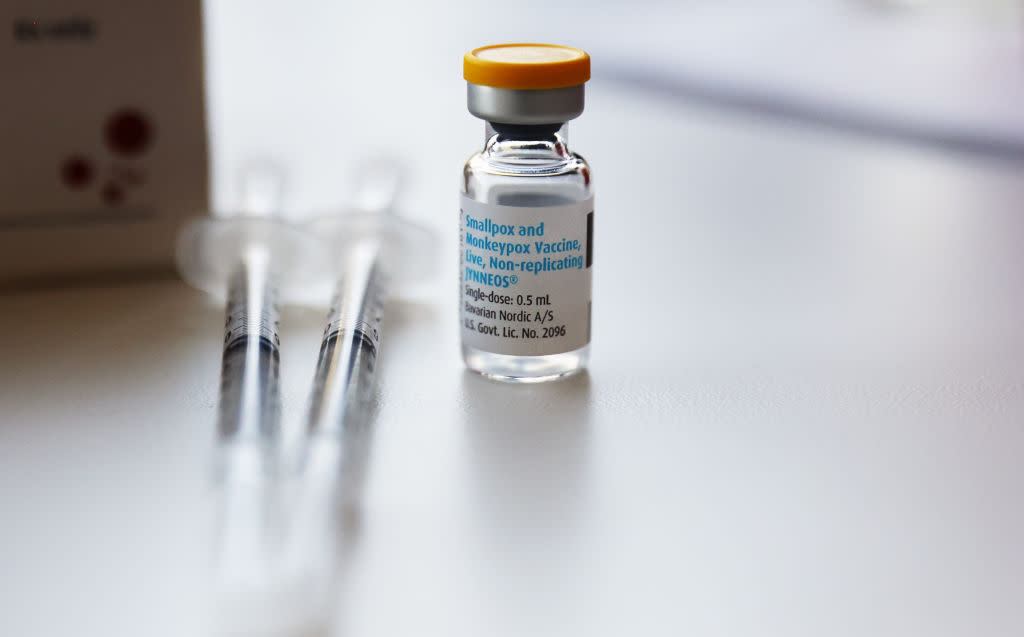FDA Recommends New Monkeypox Vaccine Strategy to Stretch Supply

A vial of the Jynneos monkeypox vaccine at a pop-up vaccination clinic operated by the Los Angeles County Department of Public Health at the West Hollywood Library on August 3, 2022 Credit - Mario Tama/Getty Images
On August 9, the U.S. Food and Drug Administration issued an emergency use authorization (EUA) for a new way of administering the Jynneos monkeypox vaccine. The move allows doctors to give patients smaller doses in order to get more shots out of each vial and protect more people quickly. It’s the latest step in the federal government’s response to the growing monkeypox outbreak, which it declared a public health emergency on August 4.
While the government has shipped nearly 620,000 doses of vaccines around the country so far, the U.S. Centers for Disease Control and Prevention (CDC) estimates about 1.5 million people are at high risk and need to get immunized with two doses of the shot. The U.S. is expecting an additional 750,000 doses of Jynneos from the manufacturer Bavarian Nordic, but they won’t arrive until September or later, said Robert Fenton, the White House monkeypox response coordinator, during an August 9 briefing.
To ensure that people at highest risk of infection are vaccinated in the meantime, the FDA is allowing doctors to get five doses out of the current one-dose vials of Jynneos by injecting the vaccine between the layers of skin (or intradermally) rather than under the skin (or subcutaneously). Being inserted into the skin layers allows the vaccine to activate immune cells that can produce a strong immune response, one that is similar to that generated by injecting the fully dose subcutaneously. During the briefing, FDA commissioner Dr. Robert Califf said that the agency reviewed data from a study performed when Jynneos was originally approved for smallpox and monkeypox in 2019, which compared the different routes of administration. “The results of that study demonstrated that intradermal administration provided similar immune response to subcutaneous administration, meaning that individuals in both groups responded to vaccination in a similar way,” he said.
CDC director Dr. Rochelle Walensky noted that many health care professionals may not have experience giving vaccines intradermally. Currently, most shots are given more deeply, into the fat layer under the skin. But the skin test for tuberculosis and the rabies vaccines are given intradermally. The CDC is launching an education campaign—through webinars, online instructional videos, and other materials—to help teach health care providers how to give Jynneos between the skin layers.
For children under age 18, the FDA advises doctors to continue giving the vaccine more deeply into the fat layer, since administering a shot between skin layers may be more challenging in the youngest children. Walensky noted that children still make up a small proportion of monkeypox cases in the U.S.
Dawn O’Connell, assistant secretary for preparedness and response in the Department of Health and Human Services, said that the U.S. currently has 441,000 doses of Jynneos vaccine in the Strategic National Stockpile, which now translates to more than 2.2 million doses if given intradermally. (To be fully vaccinated, people need two doses spaced 28 days apart.) The U.S. has already ordered an additional five million doses, which will eventually give the country an additional 25 million doses under the revised intradermal administration strategy.
So far, nearly 9,000 cases of monkeypox have been reported in the U.S., and the government has shipped more than 617,000 doses of the vaccine to states and local health departments.

